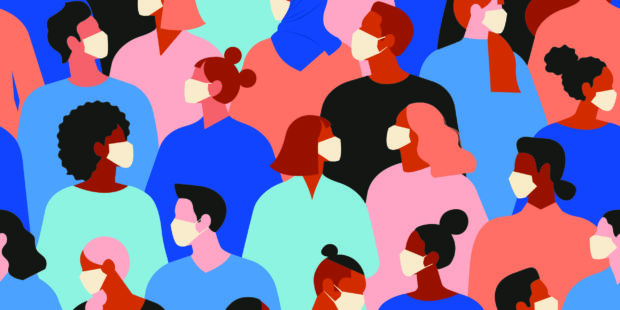
Panic-buying in supermarkets, weeks upon weeks spent in self-isolation, schools and workplaces shutting down…it’s enough to send anyone’s head into a spin.
Of course, it is indeed a frightening time and the risks posed by the deadly coronavirus must be taken very seriously but it is equally important to keep things in perspective – and look after yourself both physically and mentally.
“The thing about coronavirus is that the pace of change is fast,” says Dr Chris Hand, lecturer in psychology at Glasgow Caledonian University.
“The fact that people can’t really plan too far ahead and are constantly having to re-evaluate their plans, the lack of control that people have over their own lives naturally creates a level of anxiety.
“Then, there’s the issue of isolation. It’s quite a scary word for people to come to terms with.”
Whether you have to self-isolate after showing symptoms or are practising sensible social distancing, everyone is going to miss that closeness with friends and relatives.
“People’s self-identities will change, in that they lose contact with people who are close to them. It’s another way in which you lose control.
“Being limited in movement, all of these things can be really difficult to deal with.
“Then, of course, there is the issue of the threat to life of people you are close to, particularly older or more vulnerable relatives, people we are meant to look after, but we just don’t have that control.
“People are powerless.
“The things you would ordinarily do to support these people could actually be counterproductive in the current circumstances, which is a scary and challenging thought.
“They can all lead to anxiety, which in a general sense is an issue with things like intensive thoughts.
“Negative thoughts will creep in regardless of what an individual is trying to think about.
“There are also physiological changes such as sweating, an increased heart rate and disrupted sleep, which can have a huge effect on your wellbeing.
“Anxiety is a universal psychological experience.
“Everyone is capable of experiencing it but it becomes a problem is when it becomes uncontrollable.
“And people’s anxiousness is naturally heightened when we’re in crisis – but the most important thing is to try to manage it.
“There has been some good advice already issued by the likes of the World Health Organisation on anxiety management techniques.
“I’d certainly advise anyone with concerns to take a look.
“My advice would be to try to adapt your life to fit with the circumstances, and try not to worry too much.
“We are fortunate in this digital age that we have tools, such as online shopping, email and social media to help us manage day to day life. In previous pandemics many years ago, people had to manage without these – and survived it.”
Be kind to yourself: Dr Hand’s seven crucial steps
Switch off the TV
“Everyone wants to keep up to speed, but it’s important not to overwhelm yourself with constant information. Try to only check the news a few times a day – and use reliable sources.
“Just because something looks like it might be reputable, always make sure you check where the information is coming from, ie the NHS or World Health Organisation.”
Keep talking
“Even though we are distancing ourselves from social events, it’s important to keep in touch. Make use of Whatsapp, Skype and social media. We might be limited in physical contact, but checking in with loved ones will keep your spirits – and theirs – up.
Develop new habits
“Make sure you have a routine. It might be a new routine, such as working from home, but having some structure to your day will help you adjust.”
Eat healthily
“It is difficult because of the limited access to shops and products, but try to eat healthily.
“It is the easiest thing to do when you are fearful but try not to drink too much alcohol, and don’t binge on snacks.”
Try new things
“Use the opportunity to find new things to do, such as cooking as a family, or if you are on your own, reading a book, signing up for an online course, learning a new language, or getting that old guitar out from the back of the wardrobe and giving it a go. There’s never been a better time to try it!”
Enjoy isolation
“Social isolation doesn’t mean you are under house arrest. Get out into the garden, go jogging as long as you are careful not to get too close to others, go for a drive and if you are healthy, find a new outdoor activity to try.”
And…relax
Self-care is key to reducing anxiety. Try to take 30 minutes every day to do something that helps you relax. Go outdoors, speak to a friend who makes you laugh or just use the time to close your eyes and escape the chaos of life.
Things to make you feel better
Refresh, recharge and reawaken your senses. Pep yourself up with these activities…
Twist and reset
A simple supine yoga twist always works wonders, bringing the nervous system into a balanced state.
Lying on your back, bring your knees in towards your chest and rock gently side to side. Then, with your arms in a T shape, let your knees roll to your right for a few long, slow, deep breaths. Then, engaging your abdominal muscles to support your back, bring your knees back to centre and, as you exhale, allow your knees to fall to the left.
Simply look up at the sky. Feel the weight of your body and support of the ground beneath you and the sensation of breathing, to help you relax as much as possible.
Yoga
Squeeze regular yoga sessions into a busy lifestyle.
Yoga is a great stress-reliever, complementing high-intensity training really well. HIIT or endurance training can raise cortisol levels; yoga works as the perfect antidote by stretching your muscles.
Everyday beauty
Cherry blossom, birds singing, fresh cut grass – take time to find something beautiful that brings you joy.
Cold showers
Embrace the lighter mornings and have a cold shower – it will wake you up better than a cup of coffee. Cold exposure requires willpower. It’s a test of the mind and benefits your body, strengthening your immune system, keeping you focused and tightening your skin.
Spring cleaning
Cleaning has been found to have a positive impact on mental wellbeing by helping us gain a sense of control over our environment, while being absorbed in an activity also helps calm your mind. It also helps improve mood and provides us with a sense of satisfaction. Several studies have found clutter in our homes can have a negative impact, resulting in feelings of tension and uncertainty and over-stimulating the senses – so a good declutter can benefit home and mind!
Matcha brews
The benefits of matcha for energy have been shouted about for ages. It contains a compound called L-Theanine – a naturally calming agent – that works with the caffeine to provide what’s described as a “calm, focused and happy energy”.
It’s also packed with 10 times the amount of antioxidants as a regular cup of green tea, which helps control blood sugar and cholesterol levels, and can even boost metabolism.
The great outdoors
The change of season gives us the chance to get back out into some green space. There are lots of benefits to training outdoors: improved mood and increased dopamine and serotonin (our feelgood hormones); you get to reconnect with Mother Nature; being out in green space provides a mental health boost, and once we’re fully into spring you’ll be getting your dose of vitamin D from the sunlight, too.

Enjoy the convenience of having The Sunday Post delivered as a digital ePaper straight to your smartphone, tablet or computer.
Subscribe for only £5.49 a month and enjoy all the benefits of the printed paper as a digital replica.
Subscribe